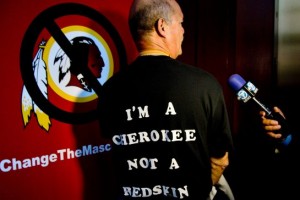Today’s blog article in the Toronto Star caught my attention as it deals with debate between the politics of sports, namely NFL football, and racial discrimination: “Washington Ponders ‘Redskins,’ By Any Other Name.” (September 8, 2013).
I feel this ties in with the on-going (and perhaps intensifying) challenge of deconstructing stereotypes we are learning about in this module of the course. Here is a recent video interview (NBC News Sept 6, 2013) of Oneida Indian Nation representative Ray Halbritter from Changethemastcot.org (a campaign to address stereotypes in print and other media).
Although I’m not an NFL fan, I’m a sports fan, and I understand both sides of the issue in using Indian monikers in sports. A dichotomy in the protection of cultural rights exists: one side argues of an 80 year heritage that brings pride out of a winning sports legacy, while the other argues a portrayal that is denigrating and dehumanizing to a large segment of the population.
Do major league sports teams like the Braves, Blackhawks, and Redskins fall under the motive of “wanabees” described by the Zimmerman et al (2000) reading? As he asserts, “Many Indian people see wannabes as a hodgepodge stereotype of their cultures, with practices taken out of context, usually in a disrespectful way.” (p. 72) One of the things that comes to my mind in sports media is the Atlanta Braves Tomahawk Chop Chant song. I can totally understand how this is viewed as offensive to native groups and why they will continue to fight for legislation change that prohibits media from portraying Indians as “a people of the past with little present-day material on it, a major stereotype rejected by many Indian people.” (p. 76).
I do believe that sports organizations and fans do not mean any offense to native groups, but I agree with the stance that “The point is that it’s about context… If you called them the (Washington) ‘Americans’ and had a contemporary native image, that’s inclusive. That’s much different than singling us out and calling us by that name and have the image of a stereotypical native American from the 19th century, as though we’re not still around.” – Kevin Gover, director of the Smithsonians National Museum of the American Indian.

